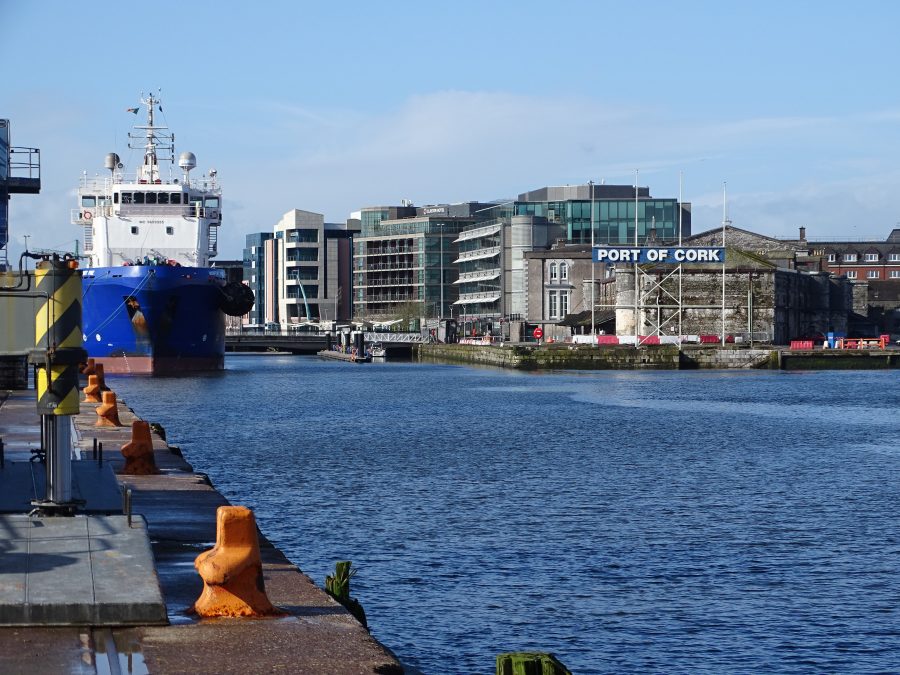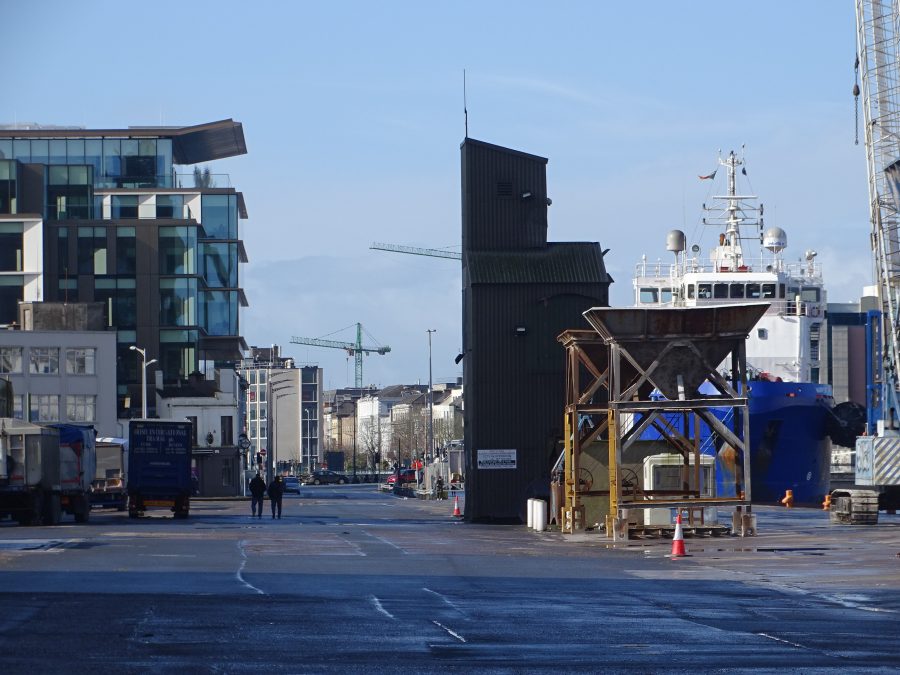
1053a. Custom House Quay (centre), Spring 2020 (picture: Kieran McCarthy)
Kieran’s Our City, Our Town Article,
Cork Independent, 18 June 2020
Remembering 1920: The Dilemmas of Dockers and Railwaymen
With the early summer of 1920 passing it coincided with violence escalating in the War of Independence. In late May and early June 1920, the Cork Examiner records several ships, which docked at Queenstown (now Cobh) and at the city’s Custom House Quay to unload British soldiers and weapons.The SS Csaritsa made a number of trips between England and Ireland bringing soldiers to be quartered in the South of Ireland. At Queenstown on 26 May 1920 the War Department vessel Sir Evelyn Wood came alongside the Deep Water Quay to discharge some guns destined for removal to Ballincollig Barracks and provisions destined for the military in Limerick. However, civilians unloading the goods onto the quayside put anything in the nature of war aside and refused to unload them.
Similar problems of resistance by dockers occurred on 7 June 1920 at the city’s Custom House Quay. The dockers would only work on the ordinary cargo from the SS Eblana. The unloading of the barbed wire from was completed by the military. Similarly, on the same day, at the unloading of the HMS Bacchus at Custom House Quay, resistance was also met. Motor lorries were removed, many of which contained ammunition. However, to discharge her it was necessary to use the crane erected on the quay. Application was made to the Board of Cork Harbour Commissioners for the key of the crane. However British soldiers did not wait for the meeting later that day and broke the crane lock to use the crane for unloading. Later in the day, the breaking of the lock drew the anger of some members of the Cork Harbour Commissioners.
At the meeting of the Law and Finance Committee of Cork Harbour Commissioners (on 7 June 1920), Cllr Seán Good, took the floor to call for solidarity of resistance amongst dockers and railwaymen. Seán was an active Trade Unionist within the Cork and District United Trades Council. He was elected in January 1920 to Cork Corporation representing the College Road district. At the meeting Seán drew attention to the breaking of the lock of the crane. He did not know whether an application had been made for the use of the crane.
Seán sympathised with the railwaymen and dockers who he deemed were doing everything they possibly could to prevent disturbances in the country. He argued that the Commissioners should not help in the bringing of people to the country to “mow them down when the first opportunity arose”. He also drew the attention of the Seamen’s and Firemen’s Union to the men working the crane. He deemed them not to be the paid servants of the British Government and called on them to continue to desist. Seán believed that as soon as the Government had completed its landing arrangements that it was going to make a “wholesale attack on the people”.
In particular, Seán Good was angry by an intervention the previous days in the British House of Commons when the question was debated on the hoisting of the Irish Republican flag over the flag staff at the Admiralty Pier, Queenstown, and across their buildings. He noted that it was “downright impertinent for anyone to question their right to do as they liked with their own flag”.
Captain Collins, supporting the general remarks of Seán Good, said that the action taken in regard to the crane was a most high-handed one. He denoted; “Any English ship, or any other ship, going into a foreign or any other port dare not disrespect the authority of the port which she entered to the extent of breaking a padlock on a crane. They are not getting the crane for nothing. It will have to be paid for, but common courtesy must be used towards the harbour authorities”. In response to the debate. Mr Lucy, as Chairman of the Board, gave directions that the key was not to be given in any circumstances until application and a decision was made by the Board.
On 17 June 1920, the HMS Bacchus arrived back off Queenstown Harbour and called upon the services of a pilot being required to enable her enter port. She blew her siren repeatedly but to no avail. No civilian pilot responded to her call. The King’s Harbour Master came out and the Bacchus was brought to Custom House Quay. The vessel had on board a cargo of motor lorries for the military. When unloading, the military sentries were armed with fixed bayonets on the quay and subsequently took up positions on the vessel itself.
Meanwhile In Dublin since late May 1920 there was an ongoing refusal continued of the members of the National Union of Railwaymen to handle munitions of war carried by cargo or express vessels. By 28 June the usual trains on the main lines ran to time but there was a serious dislocation of the service between Mallow and Tralee and on the Nenagh-Limerick and Nenagh-Dublin lines, where it was found impossible to get substitutes for the men dismissed for their refusal to work trains carrying police and military.
On 28 June 1920 a statement was issued by the Irish Labour Party with reference to the special conference they held whereby it was unanimously resolved that railwaymen would continue their refusal to work trains, which carried munitions of war. Railwaymen were also to refuse to work trains conveying armed soldiers or police in any number. Ireland’s train system descended into complete chaos and ultimately stoppage as British troops were refused to be carried.
Kieran’s new book Witness to Murder, The Inquest of Tomás MacCurtain is now available to purchase online (co-authored with John O’Mahony 2020, Irish Examiner/ www.examiner.ie).
Captions:
1053a. Custom House Quay (centre), Spring 2020 (picture: Kieran McCarthy)
1053b. Kennedy Quay, Spring 2020 (picture: Kieran McCarthy)

1053b. Kennedy Quay, Spring 2020 (picture: Kieran McCarthy)